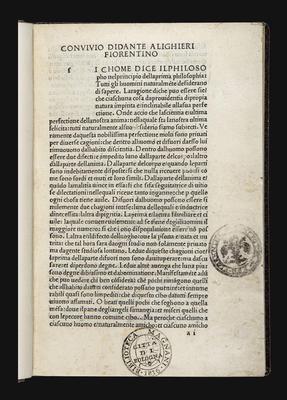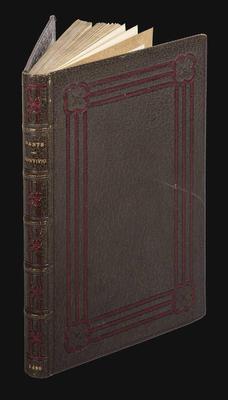Dante Alighieri
Convivio di Dante Alighieri Fiorentino.
Florence, Francesco Bonaccorsi, 20 September 1490.4° (191x126 mm). Collation: a-k8, l10. [90] leaves. Text in one column, 39 lines. Type: 1:110R, 2:78R. Contemporary inked foliation in the upper outer corner (partly shaved). Blank spaces for capitals, with printed guide letters. Early twentieth-century brown morocco with red morocco inlays, over pasteboards. Covers framed by a three fillet border in red morocco. Spine with five small raised bands, red morocco inlays in floral pattern; title and imprint in gilt lettering. Blind inside dentelles. A beautiful wide-margined copy, skilfully washed and pressed.
Provenance: an early stamp on the title-page (‘bibliot:pdd[?]florentin.'); Biblioteca Magnani, Bologna (on thetitle-page stamp dated 1816; copy sold); Livio Ambrogio collection.
The first edition of the Convivio, a work alternating compositions in verse and passages in prose: a ‘banquet' (‘convivio') of learning, in which the poems are the ‘meat' or main dish and the prose commentaries on them the accompanying ‘bread'. The work was composed by Dante between 1304 and 1307 in the first years of his exile and clearly shows his desire to rebuild his ‘good name' and to defend himself after – as he writes – ‘the perpetual infamy' of his unmerited banishment from his native city. In the Convivio, which was planned to be in fourteen books called trattati but which was left unfinished, the Florentine poet expresses his political and ethical views and deals with many scientific and especially philosophical topics.
As Dante conceived it, the Convivio was to have been a sort of summa or encyclopedia of human knowledge. It was intended for a literate but non-Latin-reading public, a wide urban readership forming part of economic, social and political structures in rapidtransformation. This explains Dante's choice of the Italian vernacular for the work, thus bestowing on it a parity of status with Latin.
Dante abandoned the composition of this ambitious work in late 1307, and only four trattati were actually written. Only three canzoni of the fourteen projected were included; their texts had been composed some time earlier, and they also had a separate manuscript circulation. These are the famous ‘philosophical' poems Voi che ‘ntendendo il terzo ciel movete, Amor che ne la mente mi ragiona, and Le dolci rime d'amor, ch'i ‘solia. This editio princeps of the Convivio is their earliest appearance in print.
The Convivio had a very late circulation. Forty-six manuscripts of the work, which all derive from a single lost codex and often contain an incorrect or incomplete version of the text, survive today; among them only two manuscripts are datable to the fourteenth century. Interest in the work increased significantly in the second half of the fifteenth century, and the Convivio was the first of Dante's so-called minor works to be published after the Commedia. For this edition the Florentine printer Francesco Bonaccorsi – whose production was largely made up of vernacular literature – used a unique and hitherto unidentified manuscript as his source.
After the Florentine editio princeps, the Convivio was published a further three times between 1521 and 1531, whereas in the seventeenth century it fell into almost complete obscurity, probably owing to Pietro Bembo's severe criticisms of the work in his Prose della volgar lingua (1525). Only in the eighteenth century was the work finally reprinted by Antonio Maria Biscioni, in the collection of Dante's Opera omnia published in 1723.



